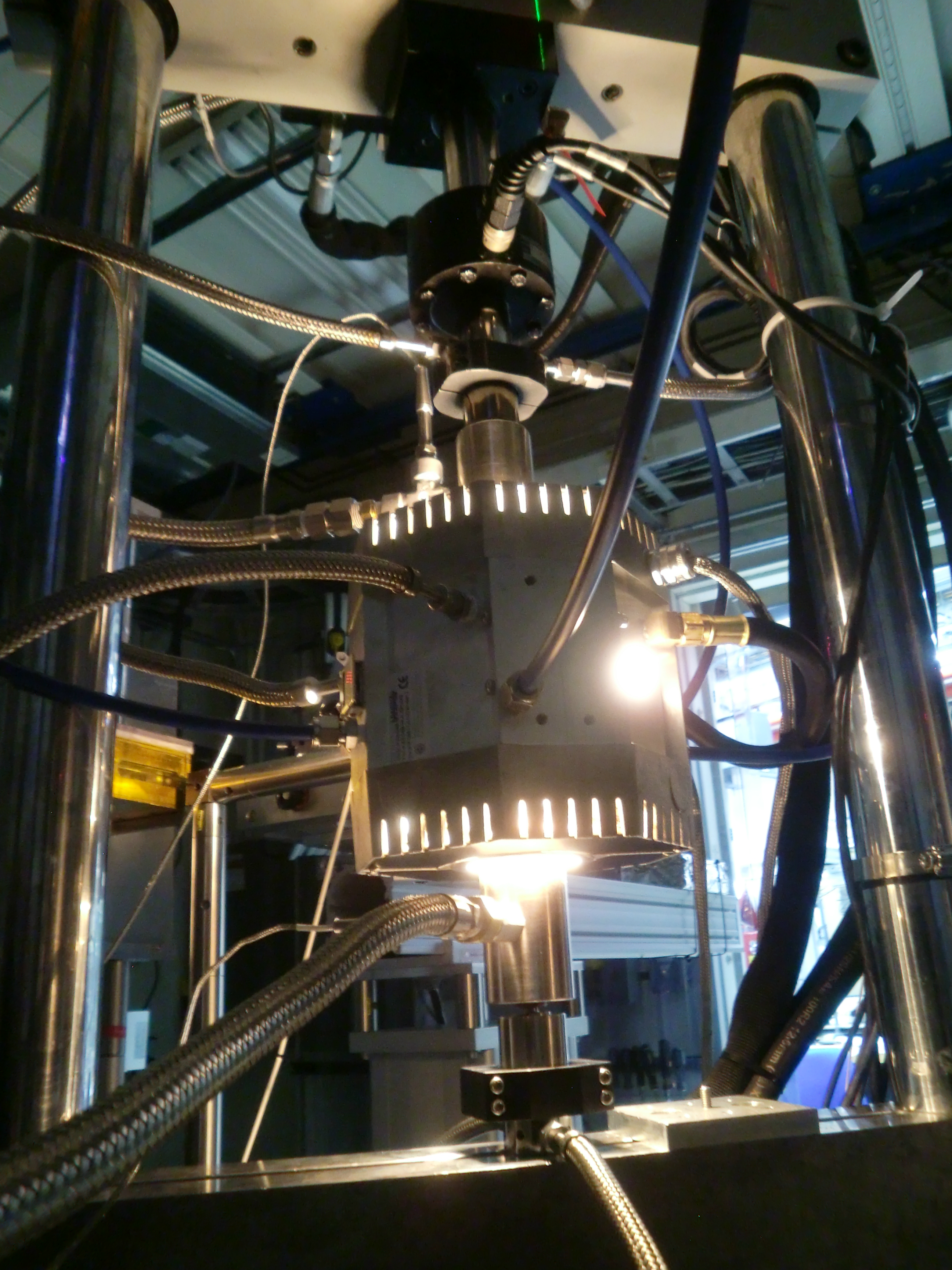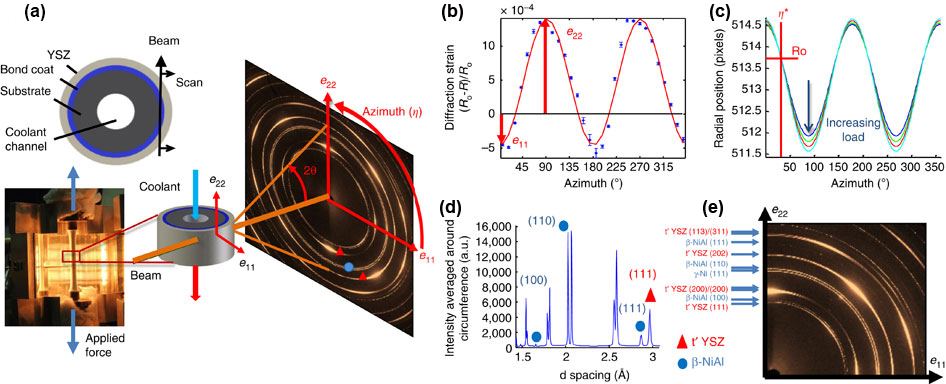Accelerated development of more energy-efficient, longer-lasting turbine blades for aircraft, along with similarly enhanced blades in use in industrial gas turbines, is the expected result of groundbreaking research carried out by a unique international partnership between scientists. These studies have produced accurate laboratory simulations of extreme conditions (temperature gradients and mechanical loadings) experienced by ceramic-coated super-alloy blades within turbine engines. The conditions during measurement are comparable to what is experienced by such blades within operational engines. Of critical importance to this novel, first-time experiment was the development of a new research instrument at the U.S. Department of Energy's Advanced Photon Source (APS), an Office of Science user facility.
The hollow blades of internally cooled turbine engines used in aircraft are under extreme conditions during flights. They experience very high temperatures including thermal cycling and stresses brought on by mechanical loads in addition to corrosion. Because of extreme conditions, the blades are manufactured from high-temperature alloys and their surfaces overlaid with a thermal barrier coating (TBC) to protect the blades. This makes them extra-durable and much more efficient over the engine's lifetime. The use of TBCs can increase the operational temperature of alloy-based turbines by 100° C (about 180° F).
Over the past 30 years or more, there has been a need to find ways to improve further the life and performance of these TBCs without relying solely on real-time flights of aircraft and demonstration engines. It is imperative to better research coating durability to prevent failure of these blades while in flight. Tasked with this goal, the research team from the University of Central Florida, Cleveland State University, Deutsches Zentrum für Luft-und Raumfahrt e.V. (DLR, Germany), and Argonne National Laboratory successfully developed a modified test facility at the Argonne APS, an Office of Science user facility. This test facility, for the first time, was able to simulate accurately the relevant extreme operating conditions experienced by turbine engines within a synchrotron beamline and provide data on the effects of those operating conditions.
A custom-built furnace and a unique coolant system (see the photo) were interfaced to the existing mechanical testing system at X-ray Science Division beamline 1-ID-B,C at the Argonne APS. The ceramic-coated tubular test objects that mimicked engine blades had an inner radius of 2 millimeters and an outer radius of 4 millimeters, for cooling of the inner-substrate surface while heating the outer-coated surface. High-energy synchrotron x-ray diffraction was used to probe the test objects at different distances from the surface. The TBC consisted of a top layer composed of yttria-stabilized zirconia, with a thickness of about two-tenths of a millimeter; a bond coat of a high-aluminum content NiCoCrAlY alloy, with a thickness of about a tenth of a millimeter; and a thermally grown oxide (TGO) layer, with a thickness of approximately 300 nanometers, which developed between the other two layers with exposure. Load and thermal instrumentation analyzed the resulting deformations and temperature changes within the coatings.
Three scenarios were used to simulate the conditions of gas turbine blades found in aircraft engines: single-flight cycles, mechanical tests at various temperatures reaching 1,000° C (a little over 1,800° F), and variations of internal cooling at similarly high temperatures. The researchers measured depth-resolved strains appearing on the coatings as thermal gradients and/or mechanical loads were applied (and varied) at elevated temperatures. Observing interactions between the x-rays and the test material, the team determined strain response through the depth of its many layers by analyzing the resulting x-ray diffraction patterns.
Through high-resolution data (see the figure), they found an association between the controlled conditions of internal cooling and external heating and the evolution of local strains. The results showed that such conditions produce strains, with the largest ones found in the TGO and at or near the interfaces between the different layers. The team emphasized that as temperatures decrease across the coating depth, major strain gradients are seen, prompting increased failure risks especially near the interface.
Based on their results, the team looks forward to conducting further research to identify ways to extend the useful lifespans of TBCs by identifying complex failure-mechanism interactions. In fact, further experiments by these scientists are planned to examine how long-term variances of mechanical loads and thermal gradients affect the performance, efficiency, and durability of coated turbine blades through full lifecycle use.
Such work will help to advance technologies in other extreme-temperature environments such as in space and hypersonic propulsion and energy conversion.— William A. Atkins
See: Kevin Knipe1, Albert Manero II1, Sanna F. Siddiqui1, Carla Meid2, Janine Wischek2, John Okasinski3, Jonathan Almer3, Anette M. Karlsson4, Marion Bartsch2, and Seetha Raghaven1*, “Strain response of thermal barrier coatings captured under extreme engine environments through synchrotron X-ray diffraction,” Nat. Commun. 5, 4559 (July 31, 2014). DOI: 10.1038/ncomms5559
Author affiliations: 1University of Central Florida, 2Deutsches Zentrum für Luft-und Raumfahrt e.V., 3Argonne National Laboratory, 4Cleveland State University
Correspondence: * [email protected]
This material is based upon work supported by the National Science Foundation (NSF) grants OISE 1157619, CMMI 1125696, and by the German Science Foundation (DFG) grant no. SFB-TRR103, Project A3. This material is additionally based upon work supported by the NSF Graduate Research Fellowship Program under grant no. 1144246. This research used resources of the Advanced Photon Source, a U.S. DOE Office of Science User Facility operated for the DOE Office of Science by Argonne National Laboratory under Contract No. DE-AC02-06CH11357.
Argonne National Laboratory is supported by the Office of Science of the U.S. Department of Energy. The Office of Science is the single largest supporter of basic research in the physical sciences in the United States, and is working to address some of the most pressing challenges of our time. For more information, please visit science.energy.gov.


